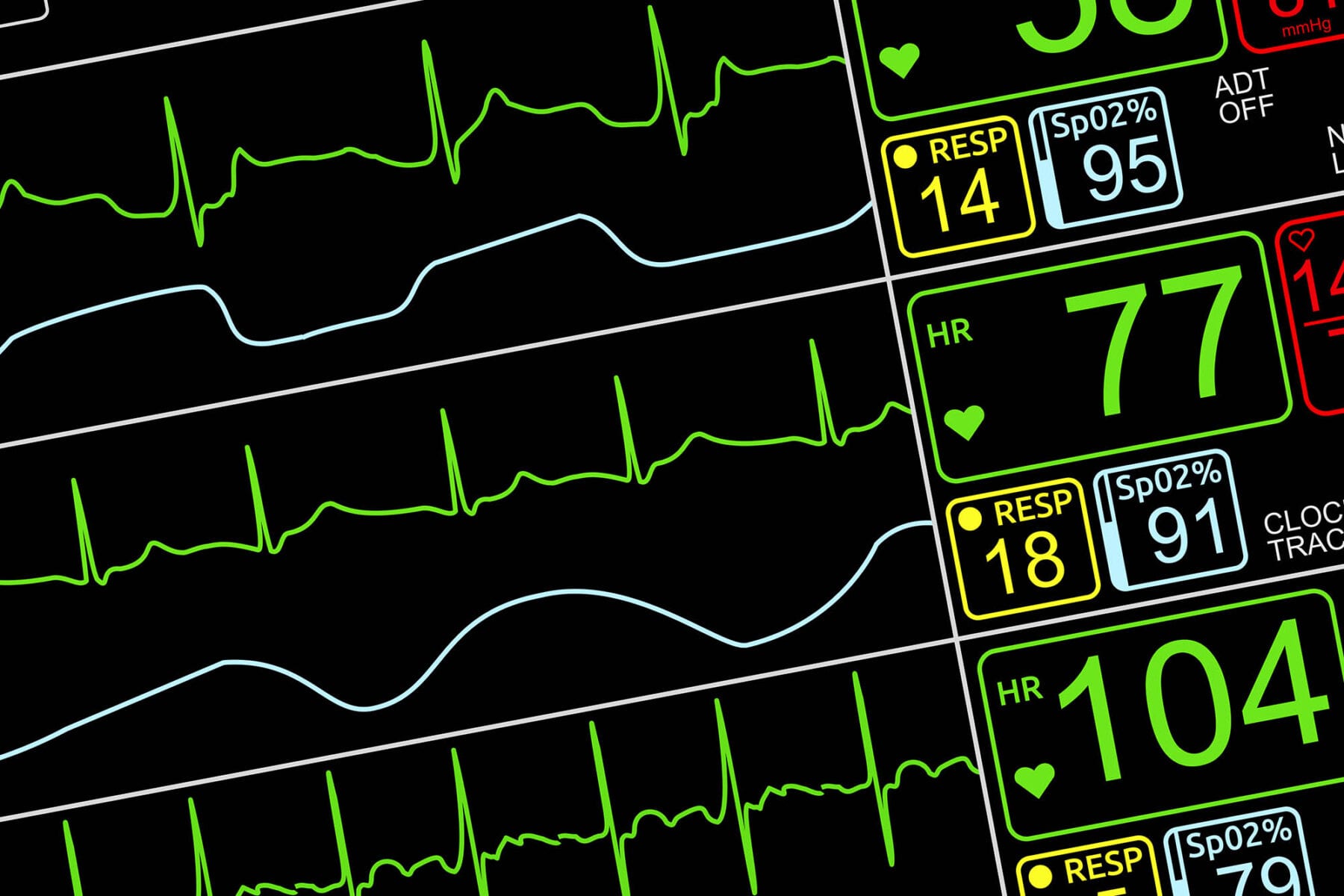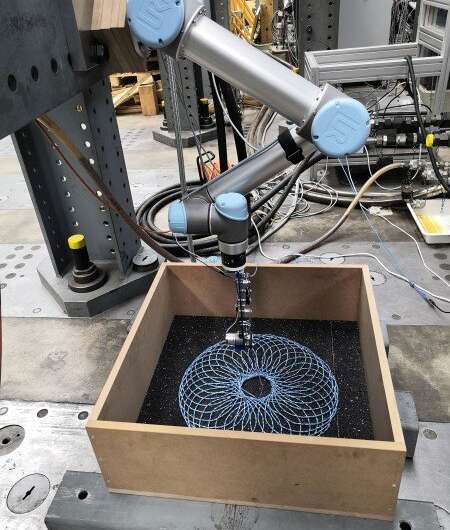
Patient’s vital signs on ICU monitor, isolated closeup, dutched left
via UVA
Scientists at the School of Medicine have identified a potential way to head off heart attacks and strokes by strengthening the fibrous caps overlying atherosclerotic plaques that naturally accumulate inside our arteries. These fatty lesions can rupture, triggering blood clots that cause disability or death.
New research from the lab of UVA’s Gary K. Owens, PhD, reveals surprising new information about the makeup of the protective caps our bodies build over these lesions, and about the factors that determine their stability. This study supports recent findings that certain types of inflammation might actually help stabilize plaques. Doctors may one day be able to use these insights to strengthen the caps and prevent the plaques from rupturing.
“These studies redefine our understanding of both how the caps form and what makes them strong,” said Owens, the head of UVA’s Robert M. Berne Cardiovascular Research Center and a member of UVA’s Departments of Molecular Physiology and Biological Physics and Internal Medicine (Division of Cardiology). “These studies were completed by a large team of highly talented investigators from UVA and abroad but led by three outstanding trainees from my laboratory, including co-first authors Alexandra Newman [PhD], Vlad Serbulea [PhD] and Richard Baylis [MD/PhD].”
UNDERSTANDING ATHEROSCLEROSIS
Unstable atherosclerotic plaques account for the majority of heart attacks and a large fraction of strokes, making these lesions the leading cause of death worldwide. The protective caps our bodies create over these lesions act like a patch on a tire, preventing them from rupturing and triggering catastrophic blood clot formation, which, in blood vessels supplying the heart or brain, can cause a heart attack or stroke. Therefore, improving our understanding of how the cap forms is of major clinical importance. “Despite decades of research, little is known regarding the factors and mechanisms that promote formation and maintenance of a stable fibrous cap,” the UVA researchers write in a new scientific paper outlining their findings.
This work from Owens and his team helps change that, offering unexpected insights into the caps’ composition and origins. Scientists have thought that the caps were derived almost exclusively from smooth muscle cells, but Owens’ findings reveal that there is a “tapestry” of different cell types involved. “For years we assumed that most of the protective fibrous cap cells were of smooth muscle cell origin because that’s what they look like under the microscope,” Newman said, adding, “Advanced techniques show us how dynamic this structure really is.”
Baylis noted that “having multiple cell types contribute to the fibrous cap likely make this critically important structure more robust and resistant to plaque rupture.”
Up to 40% of the fibrous cells in the cap in lab mice come from sources other than smooth muscle cells, the researchers found. In advanced human lesions, approximately 20%-25% of the fibrous cap cells came from other sources. Those other sources include endothelial cells – cells that line our blood vessels – and immune cells called macrophages, typically viewed as being pro-inflammatory and plaque de-stabilizing, that have undergone special transitions that enable them to perform plaque-stabilizing functions.
The researchers went on to provide evidence that the formation of the fibrous cap is dependent on metabolic re-programming of these cells to perform processes that are essential to plaque stabilization. The findings suggest that clinicians may one day be able to treat the underlying causes of heart attacks and strokes by enhancing these transitions through novel drug therapies and dietary modifications to help ensure patients have stable caps.
“Our studies unveil a potential new approach for reducing the probability of plaque rupture, which could be used in conjunction with current therapies that focus on lowering cholesterol and preventing clot formation,” Owens said.
“This paradigm-shifting study presents evidence for beneficial roles of other cell types and mechanisms driving plaque stabilization,” Serbulea explained. He added that in conjunction with previous studies from the lab, these findings provide evidence that “inflammation, often the scapegoat for heart disease, seems to reprogram endothelial cells and macrophages to help stabilize plaques.”
Taking the new results in consideration with recent clinical trials such as CANTOS, TINSAL-CVD and CIRT that have shown little to no benefit of global anti-inflammatory therapies, the UVA team is urging researchers and pharmaceutical companies to rethink their approaches to preventing heart attacks and strokes.
Original Article: Discovery Reveals Potential Way to Prevent Heart Attacks, Strokes
More from: University of Virginia
The Latest Updates from Bing News & Google News
Go deeper with Bing News on:
Atherosclerotic plaques
- Global Atherosclerosis Industry is expected to reach US$ 59,514.3 Million, growing at a consistent CAGR of 2.8% | FMI
The Global Atherosclerosis Industry is on track for significant expansion, with a projected Compound Annual Growth Rate (CAGR) of 2.8% from 2023 to 2033. This translates to a market valuation of US$59 ...
- Ancient Alleles Shed Light on Atherosclerosis Risk
Calculating the polygenic risk scores of ancient humans such as Ötzi the iceman helps researchers understand the genetic predisposition to cardiovascular disease.
- Everything to Know About Cholesterol
This forms the beginnings of an atherosclerotic plaque. Over time, that plaque accumulates more cholesterol, more fat and more immune cells, reducing the space through which blood can flow and deliver ...
- Is Hormone Replacement Therapy for Menopause *Also* Good for Your Heart? It Could Come Down to Timing
Hormone replacement therapy (or HRT) can help reduce menopause symptoms, but some studies suggest it may protect your heart as you age, too. Learn more about the HRT and heart disease connection here.
- What Is Atherosclerosis?
Atherosclerosis is a narrowing of the arteries caused by a buildup of cholesterol plaque. It may lead to stroke, heart attacks, dementia, and other health challenges. When plaque builds up and the ...
Go deeper with Google Headlines on:
Atherosclerotic plaques
[google_news title=”” keyword=”atherosclerotic plaques” num_posts=”5″ blurb_length=”0″ show_thumb=”left”]
Go deeper with Bing News on:
Plaque stabilization
- Biogen’s Surpassing Performance and Positive Outlook Affirm Buy Rating
Marc Goodman, an analyst from Leerink Partners, maintained the Buy rating on Biogen (BIIB – Research Report). The associated price target ...
- Effect of air pollution exposure on risk of acute coronary syndromes in Poland: a nationwide population-based study (EP-PARTICLES study)
There are significant disparities in the influence of air pollution depending on the demographic and socio-economic factors. AP exposure is associated with the threat of a higher risks of NSTEMI and ...
- 35th Legislature of the Virgin Islands, April 22-26 Senate Calendar
Monday, April 22, 2024 10 a.m. Perma Plaque Ceremony Earle B. Ottley Legislative Hall, St. Thomas Tuesday, April 23, 2024 10 a.m. Committee on Government Operations, Veterans Affairs and Consumer ...
- Understanding long-term effects of elevated cortisol in women over 50
Elevated cortisol can disrupt the delicate balance of hormones in the body, exacerbating menopausal symptoms such as hot flashes, night sweats, and mood swings.
- Soligenix Announces Agreement on the Design of a Second Confirmatory Placebo-Controlled Trial for HyBryte™ With the European Medicines Agency
Soligenix, Inc. (Nasdaq: SNGX) (Soligenix or the Company), a late-stage biopharmaceutical company focused on developing and commercializing products to treat rare diseases where there is an unmet ...
Go deeper with Google Headlines on:
Plaque stabilization
[google_news title=”” keyword=”plaque stabilization” num_posts=”5″ blurb_length=”0″ show_thumb=”left”]










